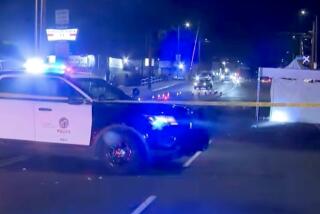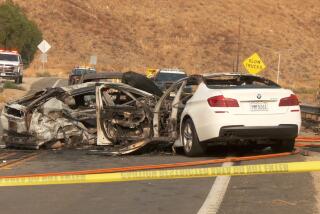Hit-and-Run Fatalities Up in San Diego, U.S.
- Share via
Martha Lidia Zamudio and her daughter, Lili Beth, were the 35th and 36th hit-and-run fatalities in San Diego County in 1989, said Mary Ann Tamburello, clerical supervisor for the San Diego County coroner. Twenty-six of those were pedestrians.
The California Highway Patrol says the latest hit-and-run points up a more sinister statistic: Nationwide, the number of hit-and-run fatalities is up dramatically. Police blame many of the deaths on alcohol and drugs, which prosecutors say is difficult to prove.
Even if a suspect was under the influence at the time the accident occurred, chances are he won’t be by the time he’s booked, investigators say. Eyewitness accounts mean little, they say, in proving substance abuse.
Tamburello said that 18 people died in hit-and-run accidents in 1986; 17 were pedestrians. The number jumped to 28 in 1987, including 21 pedestrians. In 1988, 26 of the 34 hit-and-run fatalities were pedestrians.
Fatalities nationwide showed a corresponding increase, said a spokesman for the National Highway Traffic Safety Administration.
In 1988, 1,837 people died in hit-and-run accidents; 1,308 were pedestrians. In 1987, 1,259 of 1,756 deaths involved pedestrians. And, in 1986, 1,251 of the 1,803 killed were pedestrians.
In California, 267 people were killed in hit-and-run accidents in 1988, said Alice Huffaker, a spokeswoman for the California Highway Patrol. Every year has shown an increase since 1984: 180 in 1984; 186 in 1985; 201 in 1986; 249 in 1987.
“We believe it’s fair to say that the vast majority of hit-and-run fatalities are caused by drivers under the influence,” said Jerry Bohrer, a CHP spokesman. “It’s just so hard to prove because, by the time they’re given a test, they’ve sobered up. And a witness saying they appeared to be drunk doesn’t mean anything.”
Thomas Whelan, a spokesman for the San Diego County district attorney, said hit-and-run drivers almost always evade drunk-driving charges. At minimum, a hit-and-run violation brings a sentence of 16 months to three years in prison. Whelan said a $10,000 fine is usually added on to a minimum sentence.
“If the victim suffers death or permanent injury, the sentence is usually two to four years in prison, plus loss of license,” Whelan said. “If we can prove gross negligence, the sentence is usually 10 years, tops.”
More to Read
Sign up for Essential California
The most important California stories and recommendations in your inbox every morning.
You may occasionally receive promotional content from the Los Angeles Times.










